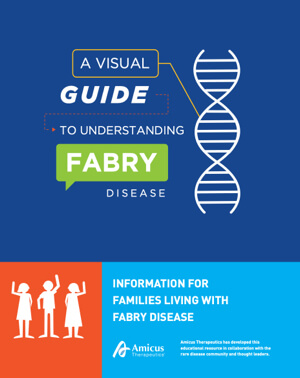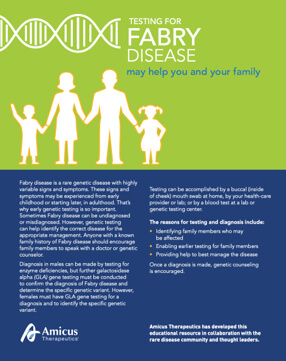
A variant in your DNA prevents an enzyme, called alpha-Gal A, from breaking down fatty substances. These substances can build up in the lysosome (the cell’s recycling center), causing damage to cells, tissues, and organs.

Learn from an expert
Fabry Disease Genetics
The most serious impact of Fabry is often seen in the kidneys, heart, and brain. However, Fabry may lead to a wide range of symptoms, which can be mild, moderate, or severe. These symptoms can change over time and tend to get worse. Below, you’ll see many of them.












Kidneys
- Protein in the urine
- Decreased kidney function
- Kidney failure

Heart
- Irregular heartbeat (fast or slow)
- Heart attack or heart failure
- Enlarged heart

Brain
- Transient ischemic attack (TIA)
- Stroke

Nervous System
- Nerve pain
- Intolerance to heat, cold, or exercise
- Burning in the hands and feet

Skin
- Sweating less than normal or not at all
- Small, dark, red spots, mostly appearing between the belly button and upper thighs

Eyes
- A whorled pattern in the cornea
- Fabry cataracts

Ears
- Hearing loss, ringing in the ears (tinnitus)

Gastrointestinal (GI)
- Nausea, vomiting, cramping, and diarrhea
- Pain/bloating after eating, feeling full after a small amount of food
- Constipation

Psychological
- Feelings of guilt, worry, depression, isolation, and/or fear

Lungs
- Wheezing
- Difficulty breathing, shortness of breath
- Bronchitis
- Chronic cough

Others
- Fatigue—A deep feeling of tiredness
Each person has a genetic variant that is unique to them. Variants can affect when you first notice symptoms, what symptoms you have, and how bad symptoms are or may become.
Think of Fabry as presenting along a spectrum, where the disease can affect some organs but not others, and you can have some symptoms but not others. Symptoms can range in severity, and the timing of when you experience the effects of Fabry may also vary.

Classic Fabry in males: Begins in early childhood, can cause many severe symptoms, and can lead to serious organ damage.

Classic Fabry in females: Can begin in childhood or later in life, and can range in severity.

Late-onset Fabry: Males and females may not experience symptoms until they are adults.

Late-onset, cardiac/renal: Males and females may not experience symptoms until they are adults. This type primarily affects the heart (cardiac) or kidneys (renal).

Uncertain significance: Males and females may or may not experience Fabry symptoms. There may be conflicting evidence of Fabry disease.
Work with your healthcare provider to find out which specific variant, and possible type, you may have.


It can be passed down.

Either parent can pass the disease down to their children, which is why Fabry is considered a family disease. Daughters always inherit Fabry if their father has it, while sons and daughters have a 50/50 chance of inheriting Fabry if their mother has it.



See a family’s experiences
Michael & Family

Join the Community
Get the latest information about Fabry disease.
Get Updates










